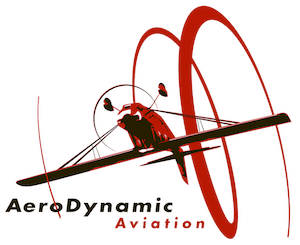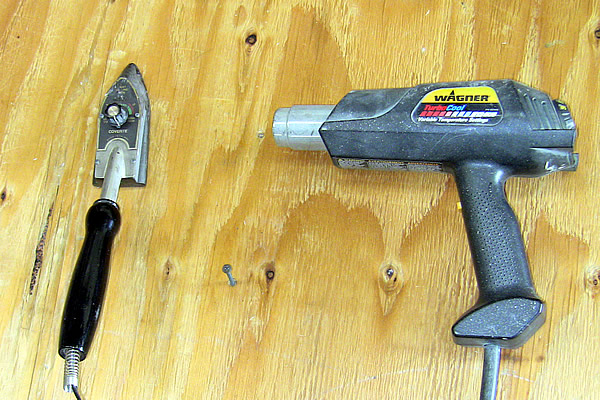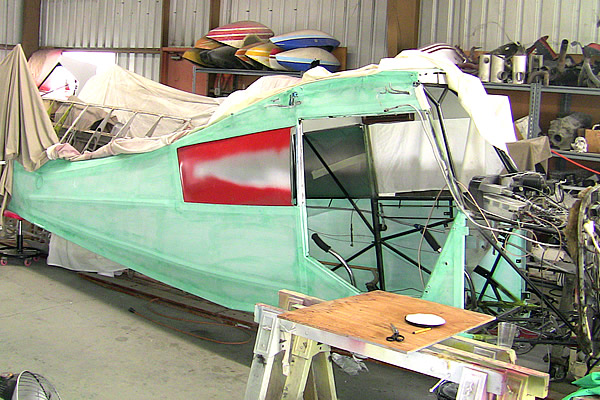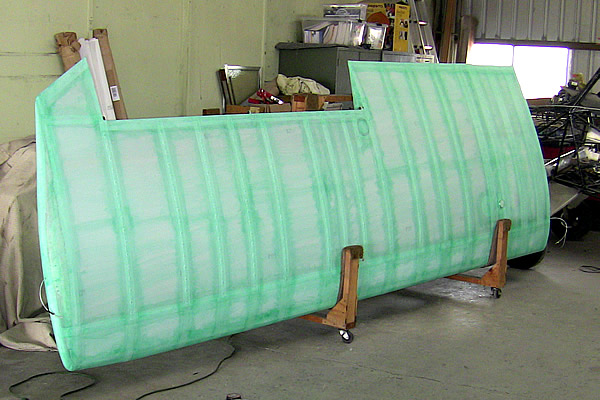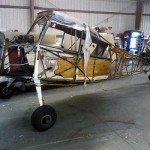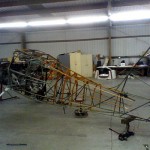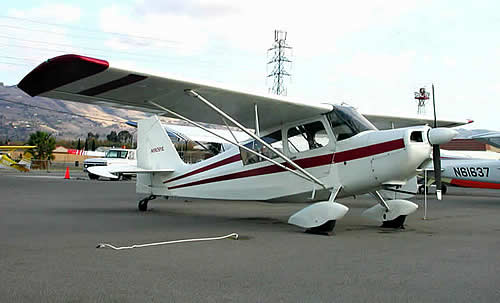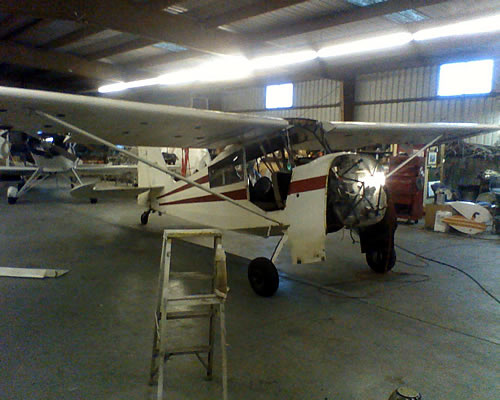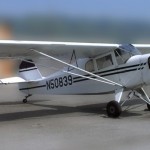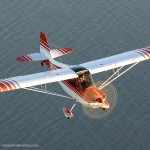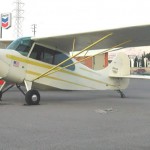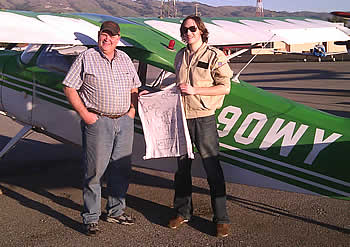citabria
posts displayed by tag
Citabria 9091L Restoration Part 3
Mar 06 2011Did you know that a hair dryer and an iron are essential tools for building an airplane? Yes indeed! The hairdryer is used to tighten the fabric once it is put on the frame, and the iron is used to iron out little wrinkles in tight places or round corners.
The method of covering has not changed much since the Wright brothers and John Montgomery. The material has changed from cotton or linen to synthetics that do not get mildew or get eaten by insects or mice, and instead of leaving the fabric “naked” it is covered with protective coats of dope. The fabric (trade name Ceconite) is 100% polyester, and woven so as to prevent any rips or tears propagating (ripstop). If you come to the hangar and ask to see it we’ll show it to you and have you try to tear it. It comes in large rolls about four feet wide and is cut and shaped and glued to the frame.
In the case of wings the fabric is also riveted to the ribs. Lift over the wing will lift off the fabric if it is not properly attached. Glue alone is not enough. Once the fabric is on and heat shrunk, protective tapes are added in stressful places and over joins, then the doping starts. Nitrate dope is brushed on by hand for the first coat or two. It penetrates the weave and sets up a good substrate for the later butyrate coats. It looks greenish when dry.
Once the nitrate is done, the work can be left to wait. However if the fabric is left to wait before any nitrate is applied, dust will get into the weave and make it very hard to achieve a good coat later. So it is essential to complete the nitrate dope covering as soon as the new fabric is put on the plane.
New Pilot: Kathleen Morse
Feb 26 2011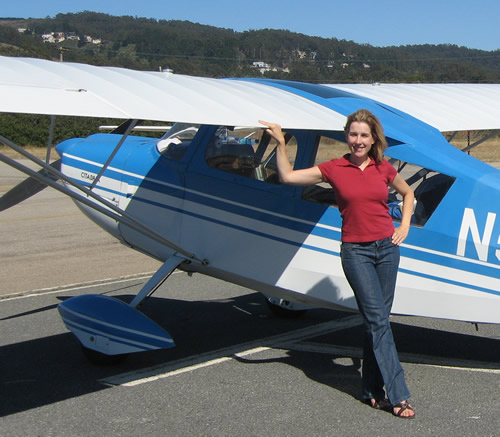 Congratulations to Kathleen Morse who added her Airplane Single Engine Land rating to her Glider Private Pilot license, in Citabria 5032G with Examiner Sherry Diamond.
Congratulations to Kathleen Morse who added her Airplane Single Engine Land rating to her Glider Private Pilot license, in Citabria 5032G with Examiner Sherry Diamond.
Well done Kathleen, and instructors Grainne Gilvarry and Jim Grant.
News: Citabria 9091L Restoration Part 2
Feb 25 2011Taking a plane apart goes quickly! The real time will be spent putting it all together. After stripping the fabric from the airframe, the framework turned up to be in surprisingly good condition. Even the fabric was ok, but the old paint job made it look bad. When too much dope is layered on to the fabric, it does not make things better, it tends to peel off in large pieces and makes the plane look like it is about to fall apart. However, stripping dope off fabric is generally not a good plan. It is less time consuming to get new fabric and start from scratch.
While the plane is under restauration, we are also planning some upgrades.
The old wings were designed for 14 gallon tanks only and we cannot upgrade them, so Al is building us a new set of wings that will have 18 gallon tanks and modern fuel gauges in each wing root. Each wing will have two new hand built sitka spruce spars, and among other things, around a thousand rivets!
The pilot seat was not adjustable, so we sprung for a new seat frame that is, so shorter pilots can bring it closer and longer legged ones can move it further away from the panel. It should also make getting in and out a little easier.
We are still deciding on a paint scheme. I like the idea of a San Jose Sharks theme. I wonder if the FAA will let us install a shark fin? Ideas welcome.
News: Citabria 9091L Restoration Part 1
Feb 24 2011As most of you will know, we took 9091L down in November for a complete restauration. Over time, the sun does have an effect on the fabric, and every ten to fifteen years a fabric covered airplane will need recovering. Here’s a picture of her while she still looked pretty:
To start the process, the engine, wings, and the tailfeathers will be removed off the plane.
The fabric covering will then be stripped off. The interior, the engine and even the landing gear will all be removed. All the metalwork will be carefully inspected, and repairs made, or pieces replaced as needed. Special attention will be paid to areas where stress is concentrated – landing gear attachment points, base of the tail, and so on.
News: Welcome to another two pilots from Spain!
Feb 19 2011I’d like to extend a warm AeroDynamic welcome to Jose Catalan Soriano and Daniel Tari Fernandez, two pilots from Spain who have come to us to learn the art of tailwheel flying and then spend some time to gain additional experience.
Congratulations to both for earning their tailwheel endorsements, and checking out in a variety of taildraggers already, including the Taylorcraft L-1, Aeronca Champ and Citabria.
Welcome: New Tailwheel Pilots From Spain
Feb 06 2011We are delighted to extend a warm welcome to two newly minted tailwheel pilots from Spain, Jose Luis Alonso Miguel and Luis Canca Pedraza. Although they are experienced pilots already, Jose and Luis have come to AeroDynamic to build tailwheel experience. The checkout did not take long and they are happily flying Citabrias now.
New Pilot: Alexander Decater
Feb 04 2011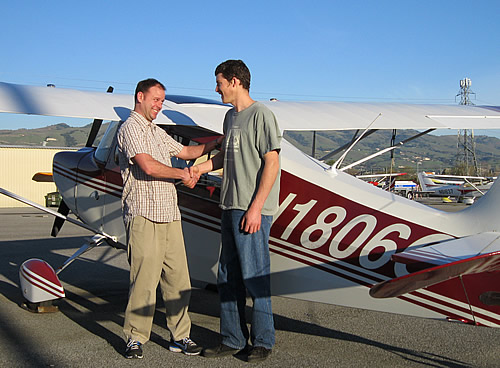 Alexander came to us at the start of January with a goal of earning his Private Pilot license in a month. I’m delighted to report he did it! Working hard with CFI Derick Day, he got 100% in his knowledge test, and aced his flight test. Well done Alexander.
Alexander came to us at the start of January with a goal of earning his Private Pilot license in a month. I’m delighted to report he did it! Working hard with CFI Derick Day, he got 100% in his knowledge test, and aced his flight test. Well done Alexander.
Going Solo: Joel Cretan
Jan 28 2011Congratulations to Joel Cretan who successfully soloed Citabria 990WY. Not only that, but his family was watching! Talk about pressure. Nevertheless he made three nice takeoffs and landings. When Joel was back on earth he had his shirttails cut off by his CFI Blake. Well done both!
